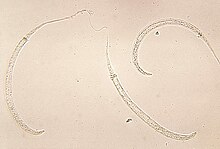Dracunculus (animal)
| Dracunculus | |
|---|---|
 |
|
| Dracunculus medinensis larvae | |
| Scientific classification | |
| Kingdom: | Animalia |
| Phylum: | Nematoda |
| Class: | Secernentea |
| Order: | Camallanida |
| Superfamily: | Dracunculoidea |
| Family: | Dracunculidae |
| Genus: | Dracunculus |
| Species | |
|
Dracunculus alii |
|
Dracunculus alii
Dracunculus dahomensis
Dracunculus fuelliborni
Dracunculus globocephalus
Dracunculus insignis
Dracunculus lutrae
Dracunculus medinensis
Dracunculus ophidensis
Dracunculus is a genus of spiruroid nematode parasites in the family Dracunculidae. Some species infest humans and alter their hosts’ behaviour in a way that supports the worm’s reproductive cycle. Dracunculus causes a blister to form on the host, often on the foot or lower leg, causing severe pain and a boiling sensation. This will cause the human host to dip the affected area in water to soothe the pain which will cause the blister to burst, allowing reproductive larvae into the water where they can await the next host to infect.
The worms can reach a metre in length. If one simply pulls off the protruding head of the worm, the worm will break and leak high levels of foreign antigen which can lead to anaphylactic shock and fast death of the host. Hence it is important to remove the worm slowly (over a period of weeks). This is typically undertaken by winding the worm onto a stick (say, a matchstick), by a few centimetres each day.
The best known species is D. medinensis, known commonly as the Guinea worm. This parasite is frequently found in the subcutaneous tissues and muscles of humans, dogs, and sometimes cattle and horses. The medical name for this condition is dracunculiasis. The disease causes cutaneous nodules and subsequent ulcers. The anterior end of the adult female worm protrudes from the host animal's body, most commonly on a lower limb, through an ulcer. When the worm feels the presence of cold water, muscle contractions in its body cause its uterus (which fills the whole body cavity) to burst, releasing hundreds of thousands of first-stage larvae into the water, where they can find new hosts.
...
Wikipedia
